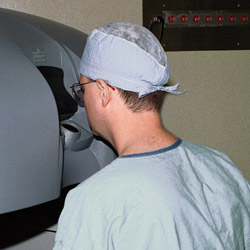
When Leonardo da Vinci invented the robot in 1495, his purpose was to prove his theory that the movements of the human body could be imitated with the use of engineering machine parts.
Some 500 years later, this technology was refined to allow robotic arms controlled by specially-trained surgeons to duplicate their exact movements in performing complex surgical procedures using a minimally invasive approach. With a nod to the famous inventor, Intuitive Surgical named its robotic surgical system the “da Vinci Surgical System,” which was approved by the U.S. Food and Drug Administration in 2000.
OSF Saint Francis Medical Center acquired its first da Vinci robot in 2002 and a second one this year. A multi-specialty Robotic Center for Excellence is being established at OSF Saint Francis with the following core group of surgeons: Dr. David Crawford, general surgery, who serves as medical director; Dr. Tracy Bochantin, general gynecology; Dr. Dale Geiss, pediatric cardiology; Dr. Sal Lococo, gynecological oncology; Dr. Ben Rhee, pediatric urology; and Dr. Sarat Sabharwal, adult urology.
Lest the term “robotic surgery” give the impression that the surgery is actually performed by a robot, Dr. Crawford emphasizes that the robot is a sophisticated tool controlled 100 percent by a surgeon. “This thing is not an auto-pilot device—all it does is what the surgeon tells it to do,” he explained.
Sitting at the robotic platform and looking at a three-dimensional image of the surgical field through view ports, a surgeon controls three robotic arms—two holding surgical instruments and the third holding a tiny camera. The camera is adjusted with foot pedals and hand controls by the surgeon performing the operation.
Robotic surgery offers an alternative to traditional laparoscopic, or minimally invasive, surgery. Minimally invasive procedures, compared to open surgeries, involve smaller incisions (5-12 millimeters), meaning smaller scars; less pain medication, resulting in less intestinal shutdown that in turn leads to faster recovery of the digestive tract; mobility restored sooner; reduced incidence of pneumonia and blood clots in the legs; lower infection rates; fewer complications; lower blood transfusion rates; shorter hospital stays; and fewer readmissions.
The robotic device facilitates the surgeons’ work in a number of ways.
“Surgeons get a vastly improved view of the operating field,” Dr. Crawford noted. “They have a three-dimensional image instead of a conventional two-dimensional image like you have on your television screen at home. In addition, because they are seated and don’t have to stand and contort their body in order to complete the operation safely and efficiently, they are physically more comfortable while they’re doing the procedure.
“The robotic instrumentation allows surgeons to do things they cannot do as easily otherwise. Pitch, which is the up-and-down motion of the instrument or the hand at its very end, and yaw, which is right-to-left motion, are returned so surgeons really have their hand-like motions back inside the patient, which they sacrifice during laparoscopic surgery.”
The fact that the surgeons control the positioning of the camera—which is not the case with non-robotic laparoscopy—is another advantage. “Surgeons don’t have to wait for someone to anticipate their next move or they don’t have to stop what they’re doing and give someone a command and wait for it to be done correctly before they can see what they want to see,” Dr. Crawford explained. “It’s instantaneous.”
There are a number of safety features built into the robotic surgical system. “If the surgeon moves his head out of the view ports, the whole thing freezes,” Dr. Crawford said. “If he repositions the camera, the hands freeze in position. It has a software self-diagnostic that runs over a thousand times a second looking for internal computer errors. It’s like your computer at home in that everything stops and you get an error message on your screen if there is a software problem. And there is also a standby and stop button that the surgeon can hit if there is a concern.”
Dr. Crawford shares his expertise in robotic surgery by writing educational pieces, including book chapters, peer-reviewed publications and abstracts for national meetings on robotic surgery. Another one of the Robotic Center for Excellence’s core surgeons, Dr. Lococo, has a manuscript in progress on this subject.
Furthermore, both of these surgeons travel throughout the country instructing other surgeons in the use of the da Vinci Surgical System as robotic surgery increases in popularity. OSF Saint Francis’ robotics program is one of only 14 sites in the country approved to offer training.
“I personally think that 10 years from now, you’ll see most operating rooms with some type of robotic device helping to facilitate surgeries,” Dr. Lococo said.
Patients who are candidates for laparoscopic surgery should consult their surgeon about robotic surgery if they are interested in having the procedure performed with this technology. “If someone is talking to you about doing something laparoscopically,” Dr. Crawford said, “you are almost certainly, but not definitely, a candidate for robotic surgery.” iBi

